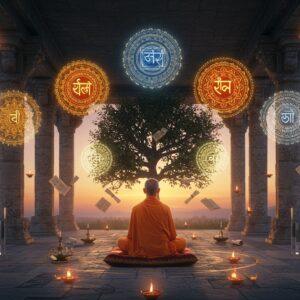
The Tolkappiyam, a cornerstone of ancient Tamil culture and literature, is among the oldest known works on Tamil grammar and poetics. This text offers a glimpse into the life and language of ancient Tamil society, serving as a crucial resource for understanding its rich literary traditions. This article delves into the Tolkappiyam’s origins, authorship, and historical significance.
What is Tolkappiyam?
The Tolkappiyam, an ancient Tamil grammar text, comprises three sections: Ezhuthathikaram (orthography), Sollathikaram (etymology), and Porulathikaram (subject matter). It offers comprehensive guidelines on Tamil language structure and usage, covering phonetics, morphology, syntax, and semantics. Furthermore, the text provides valuable insights into the socio-cultural aspects of the Tamil people, making it a truly multidisciplinary work. Understanding the Tolkappiyam allows for a deeper appreciation of the linguistic richness and historical depth of Tamil.
Who Wrote Tolkappiyam?
Tradition attributes the authorship of the Tolkappiyam to Tolkappiyar, a disciple of the revered sage Agastya. However, scholarly debate continues regarding whether Tolkappiyar was a single individual or a collective name representing multiple authors across different periods. The text reflects influences from various scholars and traditions, suggesting contributions from multiple sources. Tolkappiyar’s work is widely regarded as a synthesis of pre-existing knowledge and innovative advancements in Tamil grammar.
How Old is Tolkappiyam?
Pinpointing the exact date of the Tolkappiyam’s composition remains a challenge. However, it is generally believed to have been written between the 3rd century BCE and the 3rd century CE. Linguistic and stylistic analysis suggests it predates Sangam literature, which flourished around the same period. Archaeological and epigraphic evidence supports the Tolkappiyam’s antiquity, emphasizing its role in shaping subsequent Tamil literature and grammar. Modern Tamil writing is largely based on the 13th-century grammar Naṉṉūl, which restated and clarified the rules of the Tolkāppiyam. Other notable Tamil grammar texts include “Neminatham,” “Veerachozhiyam,” and “Nannool.” Its enduring relevance testifies to its foundational place in Tamil literary history. Tamil Brahmi inscriptions from the 3rd to 1st centuries BCE have been found in Tamil Nadu, Sri Lanka, and on trade goods in Thailand and Egypt.
Cultural Significance of Tolkappiyam
The Tolkappiyam is more than a grammatical treatise; it is a cultural document offering insights into ancient Tamil society, values, and worldview. It delves into social norms, rituals, and the intricate relationship between language and culture. The text’s emphasis on the purity and beauty of the Tamil language reflects the pride and identity of the Tamil people. Understanding the socio-cultural context of the Tolkappiyam enhances appreciation for its linguistic prescriptions.
Influence on Tamil Literature
The Tolkappiyam has profoundly influenced Tamil literature, acting as a reference for poets, scholars, and writers throughout history. Its principles are evident in the structure and style of classical Tamil poetry and prose. The text’s guidelines on meter, rhyme, and poetic conventions have shaped Tamil’s literary tradition. Studying the Tolkappiyam provides valuable insights into the evolution of Tamil literary forms and genres.
Preservation and Study of Tolkappiyam
Continuous efforts are dedicated to preserving and studying the Tolkappiyam. Scholars and institutions work diligently to conserve this invaluable text. Manuscripts and commentaries have been meticulously preserved and digitized for contemporary study. Academic initiatives and translations have made the Tolkappiyam accessible to a wider audience. Understanding the methodologies used to study ancient texts like the Tolkappiyam illuminates the challenges and rewards of preserving cultural heritage.
How Poojn.in Supports Your Tamil Cultural Journey
Engaging with ancient Tamil texts like the Tolkappiyam can be enriched by incorporating relevant spiritual items into your study environment. Poojn.in offers a selection of products that complement Tamil scholarly pursuits:
- Vibhuti (Sacred Ash): Pure vibhuti from trusted sources supports the traditional Tamil Shaivite practice of applying sacred ash during study. Available in convenient packaging for daily use. Shop now.
- Traditional Brass Lamps: Lighting a lamp before studying is a common practice among Tamil scholars. Poojn.in offers a collection of authentic brass lamps in various traditional South Indian designs, perfect for creating a conducive learning atmosphere. Shop now.
- Copper Items: Poojn.in stocks pure copper items like water containers and plates, commonly used in Tamil households during scholarly activities and rituals. These items add a touch of tradition to your study space. Shop now.
- Dhoop and Sambrani: Burning natural incense is a traditional element of Tamil learning sessions. Poojn.in’s pure dhoop and sambrani products create the perfect atmosphere for studying texts like the Tolkappiyam. Shop now.
Visit Poojn.in to explore our full range of authentic puja items that enhance traditional Tamil learning practices. We ensure all products meet strict quality standards and are sourced from reliable manufacturers, delivering across India with secure packaging and timely service.
Conclusion
The Tolkappiyam stands as a testament to the richness of ancient Tamil culture and language. By exploring its origins, authorship, and profound impact, we gain a deeper understanding and appreciation for this remarkable work. It is more than just a grammar text; it’s a cultural treasure that offers insights into the life and values of the Tamil people. Its influence on Tamil literature and the ongoing efforts to preserve it highlight its enduring significance. As we continue to study and celebrate the Tolkappiyam, we honor the legacy of Tamil tradition and ensure its wisdom is passed on to future generations.


